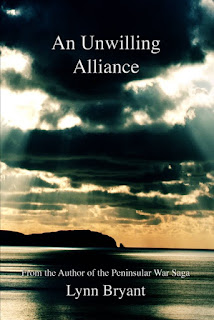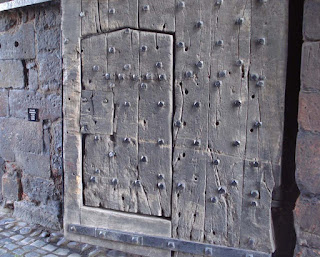I don't often do Guest Posts, but I'm making an exception today for a writing colleague whose books I admire. (To celebrate her new publication, Lynnn is making the first book, An Unwilling Alliance available from 1st to 5th November 2019 FREE on Amazon here. Don't miss this opportunity!)
This Blighted Expedition is set during the disastrous
Walcheren Campaign of 1809, where the largest British operation of the war,
consisting of 40,000 men and around 600 ships fell apart due to a combination
of poor planning, poor leadership, bad weather and an epidemic of ‘Walcheren
fever’ which killed more than 4,000 men and left another 12,000 still sick by
February 1810. It’s the second book in the Manxman series, which began with An
Unwilling Alliance and is told from the point of view of six
characters.
 Three of them are from the first book, including Captain Hugh
Kelly, who is the Manxman of the title, his wife Roseen and his first officer,
Lieutenant Alfred Durrell. There are two army men, Giles Fenwick, who later
appears in the Peninsular War Saga and Ross Mackenzie, a new character and
there is also a Dutchwoman, Katja de Groot. All the characters bring something
different to the story, but if I had to make a choice, I would unhesitatingly
say that this book belongs to Durrell.
Three of them are from the first book, including Captain Hugh
Kelly, who is the Manxman of the title, his wife Roseen and his first officer,
Lieutenant Alfred Durrell. There are two army men, Giles Fenwick, who later
appears in the Peninsular War Saga and Ross Mackenzie, a new character and
there is also a Dutchwoman, Katja de Groot. All the characters bring something
different to the story, but if I had to make a choice, I would unhesitatingly
say that this book belongs to Durrell.
Durrell is twenty-five at the start
of this book, and has been in the navy since he was a boy. He comes from a
family of minor gentry in Kent. Durrell’s father was not wealthy but was
fortunate enough to have the patronage of the first Earl of Chatham and then
later, after the Earl’s death, of his two sons, the second Earl and William
Pitt, the prime minister.
In the late eighteenth and early
nineteenth century, patronage was king. Put in it’s simplest terms, political patronage is the
appointment of a man to a government post on the basis of
partisan loyalty. In the days before Parliamentary reform, when many boroughs
were controlled by a local landowner, this could also mean the gift of a seat
in the House to a man whose duty it then was to support his patron’s interests.
Durrell’s father had
enjoyed the patronage of the Pitt family right from the start of his career. He
felt an immense sense of loyalty to the family, and held several different
posts under the old Earl and then his sons, ending up working at the Admiralty
when the second Earl of Chatham was First Lord of the Admiralty.
Both Henry and
Alfred Durrell were helped in the early stages of their career by the Pitt
interest. The two brothers went to Harrow, but while Henry fitted in well and
enjoyed his schooldays, Alfred was unhappy and it was decided that he should go
into the navy. He began his navy career as an ‘officers’ servant’ and worked
his way up to midshipman and then to lieutenant. It was necessary to take an
examination to become a lieutenant, and we are told had Durrell passed his with
ridiculously high marks. From there, he held junior lieutenants posts on
several different ships before obtaining the post of first lieutenant aboard
the Iris in 1806. He was young for
the post, and Hugh Kelly offered it to him on the basis of a letter of
recommendation from the Earl of Chatham.
Durrell’s
relationship with Kelly is one of the pleasures of writing these books. In the
early stages, it seems very unlikely that the two men can be friends. They come
from very different backgrounds and have very different personalities. Kelly is
Manx, his father held a smallholding near South Barrule and drank himself to
death after his landlord evicted him for failing to keep the land in good
order. Kelly joined the navy as a volunteer, and worked his way up through the
ranks without patronage or privilege to help him. He gained his education
through the navy and although these days he is very comfortable mixing with all
social classes, he’s aware that some people will always see him as a Manx farm
boy.
Durrell, in
contrast, comes from a good family who mix in the highest circles. He and his
brother were presented at court and he has maintained links with the Pitt
family. Despite this, he lacks Kelly’s social confidence. He is tall and slim,
with the sense that he never knows what to do with his long limbs. We know
nothing about his relationships with women, except that his brother teases him
about his lack of experience. Durrell likes rules and regulations and has a
strong sense of duty and a very good work ethic. He is also brilliant, with a
phenomenal memory but in his early days with Hugh, he has no idea when to shut
up and his lengthy speeches make Hugh want to thump him.
In An
Unwilling Alliance, we see Durrell and Hugh getting to know each other
and learning to work together. It isn’t easy, and there are times when Hugh
wonders if he made a mistake in his choice, but gradually we see the ice
thawing and by the time we meet Durrell at the beginning of This
Blighted Expedition, Hugh knows his value and is furious when Sir Home
Popham manages to get Durrell seconded to him for the duration of the campaign.
Durrell has a very
good relationship with Roseen, Hugh’s young wife. They are fairly close in age,
although Roseen is often quite maternal towards him, which makes Hugh laugh.
Despite Durrell’s shyness around women, he has a younger sister at home, and
once he gets to know Roseen, they develop a close friendship which probably
helped to smooth out some of the early difficulties between Hugh and Durrell.
Durrell is a
serious-minded young man and feels immense loyalty to the Earl of Chatham, the
rather ineffectual commander of the army in Walcheren. There is a sense of
mutual liking and even affection between them although the relationship is
always very formal; Durrell understands the rules of patronage and theirs is
not an equal relationship.
During this book,
Durrell is away from the Iris for
much of the time, acting as aide-de-camp
to Sir Home Popham. Popham and Durrell met in the first book and their
relationship is very complicated. Durrell has huge admiration for Popham’s
abilities and is keen to learn from him, but he does not trust him and feels
uncomfortable about serving under him.
While Durrell was
working his way up the ranks of the navy, his elder brother Henry was appointed
to a series of government posts through the Pitt interest, very much as his
father was. Unlike his father, Henry is not content with this. He is ambitious
and unscrupulous and Durrell quickly realises that there is more to Henry’s
appointment to Lord Chatham’s staff during the campaign than meets the eye. In
addition, Henry is paying court to Miss Collingwood, the very young daughter of
a City merchant and Durrell does not trust his brother’s intentions towards
her. As the campaign begins to fall apart, the relationship between Durrell and
Henry begins to crumble, revealing tensions that began in boyhood.
A friend who has read This
Blighted Expedition, told me that she loved this book because in this
campaign, the typical hero-types don’t get much opportunity to be heroic.
Instead, the real hero of this book is First Lieutenant Alfred Durrell;
awkward, earnest and brilliant. This book is Durrell’s coming-of-age. Durrell
started out as a somewhat comic foil to Hugh Kelly and proceeded to steal every
scene I’ve ever written him into. I hope my readers come to love him as much as
I do.
This
Blighted Expedition
is available on Amazon kindle here and will be out in paperback by
the end of November. To celebrate publication, the first book, An
Unwilling Alliance is available from 1st to 5th
November 2019 FREE on Amazon here.
In
the meantime, I am about to embark on book six of the Peninsular War Saga. It’s
called An Unrelenting Enmity and to give myself a kick start with the
writing process, I am attempting NaNaWriMo for the first time ever. To follow
my progress why not join me on my blog over at Writing with Labradors, or on Facebook or Twitter?









 x
x




